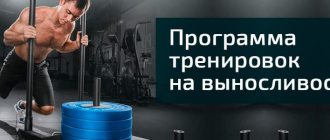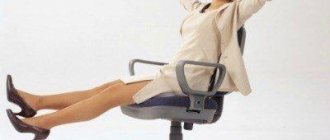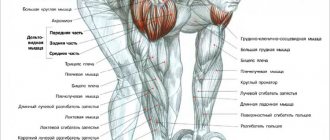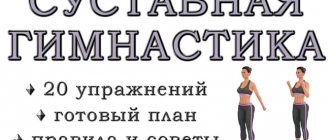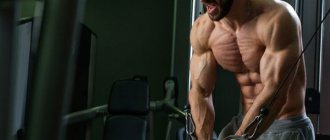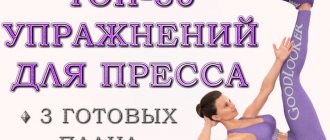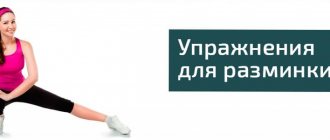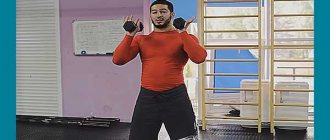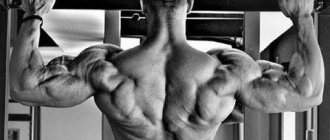Evgeny Sandov is one of the greatest representatives of strength sports of the 19th century, in addition, he is considered the founder of bodybuilding. Being a natural athlete, Eugene was really in good shape and the surviving photographs are an example of this. That is why we will look at dumbbell gymnastics, which Sandov himself performed in the morning and recommended doing it to everyone who wants to be a healthy and physically developed person.
Evgeniy Sandov - the father of bodybuilding
Evgeny Sandov is considered the father of modern bodybuilding, although he was a circus strength athlete.
At the end of the 19th and beginning of the 20th centuries, he set strength records in weightlifting. He was also known for his power routines in the circus. But that's not why he was remembered.
Evgeny Sandov was the first who began to demonstrate and promote the beauty of a physically developed body.
He did this while performing in the circus. In between power routines, Evgeniy took various static poses, showing the beauty of his body. In the modern language of bodybuilding - posing.
He combined perfectly developed muscles with high intelligence. He had good knowledge of medicine. Sandow even wrote several books on the topic of physical development.
The most famous is “Strength and how to become strong,” which describes in detail the method of training with dumbbells. The system was recommended not only for men, but also for women and even children.
Also there you can find tables for determining the training load and muscle atlases, so that exercisers understand what muscles they are pumping and where these muscles are located.
If Sandow published this book now, it would probably be called “Encyclopedia of Modern Bodybuilding.” In any case, it had no analogues in the 19th century.
Biography of the athlete
A weightlifter with the Russian name Evgeny Sandov was born on April 2, 1867 in the German city of Königsberg (now Kaliningrad) and was named Friedrich Wilhelm Müller at birth. His father was a purebred German, and his mother was Russian. The family professed Lutheranism, one of the oldest movements in Protestantism, which means they adhered to strict morals. As a child, Friedrich was sick a lot, had a frail and sickly appearance, and was ridiculed by other children. As a young man, he entered the medical faculty of the University of Königsberg, and discovered the world of human anatomy. Studying in theory the structure and functioning of the human body, the young man became interested in physical activity. Over time, they helped him get rid of muscle weakness and gain strength and endurance.
Then fate led Friedrich to a circus show, for which he took the creative pseudonym Evgeniy Sandov, remembering his Russian roots. In the circus, he demonstrated the beauty of his muscles, as well as strength and acrobatic tricks, horse riding (stunts on a galloping horse). The young man was also involved in wrestling, although over time he gained fame as an invincible fighter, with whom no one could compare. Therefore, later he completely moved away from wrestling and focused on demonstrating the beauty and power of the human body; he really enjoyed performing. Sandow simply had to become a student of the legendary mentor - coach Louis Durlacher, who was nicknamed Professor Attila. This man trained many professionals in his “Broadway” hall in New York; both the leadership of sports communities and simply talented athletes turned to him. The Professor's method was revolutionary and very effective, and Eugene Sandow (Sandow's English name) became one of his best students. Evgeniy was able to build a career and achieve considerable success in the field of bodybuilding. One of the areas of his professional activity was drawing attention to sports and its popularization - he implemented this in the field of athletic shows, with which he traveled all over Europe and the USA. The second direction was medical and research activities, which led to the writing of books and guidelines for athletes and a wide range of readers. In addition, Sandow contributed to the opening of physical training salons, which became the prototypes of modern gyms. They had the necessary equipment for strength training and trained trainers. In 1901, he held the world's first competition for athletes in Great Britain, something like modern competitions. In 1911, Sandow was awarded the title of professor of physical culture. The athlete died at the age of 58 from a stroke, which, according to assumptions, occurred from an overload of the cardiovascular system. He was buried in a London cemetery, in a simple grave without a headstone. This was the order of his wife, with whom his relationship deteriorated in the last years of his life. From his only marriage there are two daughters left.
Basic principles of the Sandow system
The training system of Evgeniy Sandov, compared to modern bodybuilding methods, is very simple and uncomplicated. But do not forget that the author created it more than 120 years ago.
The basic principles of the Sandow system have not lost their relevance today:
- Progressive load principle
In the beginning, it was recommended to gradually increase the number of repetitions in all exercises. And only after reaching the upper limit of repetitions, increase the weight of the weight.
Sandow himself advised increasing the weight of dumbbells once every six months.
- Regularly and persistently improve the brain-muscle connection (neuromuscular connections)
Sandow argued that volitional and conscious muscle tension is even more important than lifting weights.
It was in mental concentration on the work of the muscles that Sandov saw the development of real strength.
- Mandatory use of static (isometric) exercises
The author considered daily static muscle tension (a prototype of posing) to be one of the main conditions for progress, along with dynamic exercises.
Load regulation using the Sandow system
The training system with dumbbells had a clear plan for regulating loads. In essence, this is the periodization of loads in the macrocycle.
Sandow described the training loads in great detail for children, adolescents, women and adult men. He presented all this in the form of tables that were simple and convenient to use.
For example, for men it was recommended to start regular training with 2 kg dumbbells.
Classes were to be held every day. All exercises were performed in only one approach.
It was necessary to start with the minimum number of repetitions indicated in the tables. Gradually the number of repetitions increases by 2-3 repetitions, every other day, until the upper limit of repetitions is reached.
After six months the program was considered completed. The weight of the dumbbells increased by 1-2 kg and the entire load cycle was repeated again.
Text of the book “Iron Samson’s unique system of isometric exercises”
“Strength and how to become strong” (Evgeniy Sandov’s system of physical development)
At the beginning of our century, the system of physical development of the athlete Evgeniy Sandov, “Strength and how to become strong,” was very popular.
Sandow, using his medical knowledge and experience of training under the guidance of his trainer Attila (L. Durlacher), developed a system of physical exercises with dumbbells and recommended it not only to men, but also to children and girls, for whom a special dosage of exercises was provided. The system was accompanied by an anatomical table, which indicated the main human muscles, the contraction of which performed this or that exercise. Sandov is credited with the invention of “spring dumbbells,” which are still in production today.
Acquaintance with this system began with the following recommendations:
– The body, like a child, needs education, and such education can only be given by a series of exercises, with the help of which not only muscles develop, but health improves.
– Do not set a strictly specific time for studying. Choose the part of the day that is convenient for you. But in any case, exercises should be performed no earlier than two hours after eating.
– Exercises should be performed in front of a mirror and monitor the correct movements, which should be calm. Each exercise should take 2 seconds.
– Don’t force the weight of the dumbbells and the number of repetitions to increase.
– After exercise, take a cold bath. But first you need to prepare the body for these procedures by hardening (bathing), which should begin in the summer and continue all year round, day after day, in the morning. If it is not possible to take a bath, then after exercise you need to wipe your body with a towel soaked in cold water, and then quickly rub your body with a dry towel.
– The “nail” of the Sandow system lies in conscious muscle contractions when performing exercises. “You need to achieve the ability to concentrate your mind on your muscles and subordinate them to its absolute influence.”
– In addition to the basic system with dumbbells, Sandov recommends exercising muscle tension throughout the day. For example, when you are resting while sitting, try to contract the muscles of your body more and more.
Sandow addressed his students with the following words: “Do not give in to apparent difficulties; if you want success, then go forward, never retreat.”
The dosage of these exercises is intended for the age group of 17 years and older. For initial training, you need to use dumbbells weighing 2 kilograms, after every six days of training the number of repetitions increases by 3, after six months (1st course) the weight increases by 1 kg, and again the exercise should be performed from the initial dosages. (In some editions of the Sandow system, the dosage of repetitions is slightly different.)
1. Standing, arms with dumbbells along the body, palms facing forward (underhand grip), look straight ahead.
Alternately bend and straighten your arms at the elbow joints. Elbows should remain motionless.
Repeat the exercise 50 times. Breathing is uniform and arbitrary. The exercise develops the biceps brachii muscles (biceps) (Fig. 316).
Rice. 316
2. The same exercise, but hold the dumbbells with an overhand grip. Repeat the exercise 25 times.
3. Standing, arms with dumbbells to the sides, palms up, look straight ahead. Alternately bend and straighten your arms at the elbow joints. Do not lower your elbows while performing the exercise. Breathing is uniform and arbitrary. Repeat the exercise 10 times. The exercise develops the biceps brachii muscles and the triceps brachii muscles (triceps) (Fig. 317).
Rice. 317
4. Standing, arms with dumbbells to the sides, palms up. Simultaneously bend and straighten your arms at the elbow joints. Bending your arms, inhale, while extending, exhale. Repeat the exercise 10 times. The exercise develops biceps and triceps (Fig. 318).
Rice. 318
5. Standing, arms with dumbbells raised forward, palms inward. Spread your arms straight to the sides and inhale, quickly return to the starting position - exhale. Repeat the exercise 5 times (Fig. 319).
Rice. 319
6. Standing, hands with dumbbells to your shoulders, turn your shoulders, look straight ahead. Alternately raise and lower your arms. Breathing is uniform. Repeat the exercise 15 times. The exercise develops the triceps brachii, deltoid and trapezius muscles (Fig. 320).
Rice. 320
7. Standing, arms with dumbbells along the body, back slightly bent. Alternately raise your straight arms forward to shoulder level.
Raising your right hand, inhale, raising your left hand, exhale.
The exercise develops the deltoid muscles (Fig. 321).
Rice. 321
8. Standing, arms with dumbbells to the sides, palms down. Simultaneously and quickly rotate your hands up and down, then forward and back. Breathing is uniform. Perform the exercise until fatigue sets in. The exercise develops the muscles of the forearm and strengthens the wrist joints (Fig. 322).
Rice. 322
9. Hold the dumbbells at one end and raise your arms to the sides. Without bending your elbows, rotate your hands back and forth. Breathing is uniform. Perform the exercise until fatigue sets in. The exercise develops the muscles of the forearm and strengthens the wrist joints (Fig. 323).
Rice. 323
10. Standing, arms with dumbbells raised up. Without bending your legs, lean forward and touch your hands to the floor - exhale. Return to the starting position – inhale. At first, perform the exercise without dumbbells. Repeat the exercise 10 times. The exercise develops the back muscles and mobility in the lumbar spine (Fig. 324).
Rice. 324
11. Standing, hands with dumbbells along the body. Lunge forward with your left leg, raise your right arm in an arcing motion to chest level - inhale. Return to the starting position - exhale.
Then lunge forward with your right leg and raise your left arm forward. Repeat the exercise 10 times. The exercise develops the deltoid muscles and leg muscles (Fig. 325).
Rice. 325
12. Push-ups while lying on the floor. The torso and legs should form a straight line. Bending your arms, inhale, while extending, exhale. Bending your arms, touch your chest to the floor. The exercise develops the triceps muscles of the shoulder, pectoral muscles and muscles of the shoulder girdle.
Sandow himself could do 200 push-ups within four minutes (Fig. 326).
Rice. 326
13. Standing, arms along your body, look straight ahead. Raise your arms straight up through your sides – inhale. Lower to the starting position – exhale. Repeat the exercise 10 times.
The exercise develops the deltoid muscles and trapezius muscles (Fig. 327).
Rice. 327
14. Standing, hands with dumbbells along the body. Bend your torso to the left side, bend your right arm so that the dumbbell touches your armpit. Then bend in the other direction, bending your left arm. As you bend over, exhale and return to the starting position – inhale. Repeat the exercise 25 times. The exercise develops the lateral abdominal muscles, biceps, trapezius and deltoid muscles (Fig. 328).
Rice. 328
15. Lying on your back on the floor, arms with dumbbells raised up. Sit down and bend forward - exhale. Slowly return to the starting position - inhale. At first, the exercise can be performed without dumbbells. Repeat the exercise 3 times. The exercise develops the abdominal muscles (Fig. 329).
Rice. 329
16. Lying on your back on the floor, hands behind your head. Raise your straight legs up – exhale. Slowly lower your legs to the starting position – inhale. Repeat the exercise 3 times. The exercise develops the abdominal muscles and quadriceps muscles of the thigh (Fig. 330).
Rice. 330
17. Standing, heels together, toes apart, arms with dumbbells lowered along the body. Slowly rise onto your toes – inhale, then, lowering onto your heels, squat – exhale. Repeat the exercise 25 times. The exercise develops the calf muscles and quadriceps muscles of the thigh (Fig. 331).
Rice. 331
18. Standing, arms with dumbbells are lowered along the body. Bend and extend your hands at the wrist joints. Breathing is uniform. Repeat the exercise 25 times. The exercise develops the muscles of the forearm and strengthens the wrist joints (Fig. 332).
Rice. 332
Sandow claimed that by the end of the eighth course, when the weight of the dumbbells reaches 8 kg, those training according to his system will have the same muscles as his.
About the training of famous strongmen
Fans of athleticism will be interested in getting acquainted with the training of famous strongmen and using the most useful recommendations in their physical exercises.
How Samson trained
If we trace the life path of Alexander Zass, we can say that it was based on constant, purposeful work combined with a strict regime. In one of the photographs, where “Samson” is captured sitting at a table near a samovar, there is his note: “5 minutes of rest.” But he was then 74 years old, and he continued to work, training animals.
In his youth, Alexander Zass tried many systems of physical development. He started, like many at that time, with the Sandov system of physical development, then, on the recommendations of Dmitriev-Morro and Peter Krylov, he began to include exercises with weights and a barbell in his training.
He juggled with weights, squeezed, pulled out and threw them upside down, squeezed two-pound weights on his little fingers. With a barbell, I performed a bench press in a soldier's stance, squeezed the barbell from behind my head, twisted it with one hand, and squeezed the barbell while standing on a wrestling bridge. But still, Alexander was more attracted to the power tricks that he saw in the circus. And so his sports equipment began to transform, beginning to look more like the props of a circus athlete: metal rods of different thicknesses and lengths, chains, horseshoes, forged nails with heads of a larger diameter than usual, all kinds of devices for “dental numbers”, etc.
It should be said that Zass had all his sports equipment, except weights, homemade and he constantly updated and improved it. So, with the help of a blacksmith he knew, a ball barbell was made, the kind that Alexander had seen in circus athletes. The balls were hollow and could be filled with sand. This is how the weight of the bar changed. The barbell did not rotate, which made it difficult to perform some exercises, such as barbell cleans. Bulldogs were also homemade (dumbbells weighing more than 16 kg were called that). Alexander had a whole set of them: 16, 24, 40 kg.
Zass paid great attention to developing finger strength. In addition to the usual exercises of winding a cord with weight on a stick, he constantly carried with him a thick “Arabian” ball, which he squeezed with his fingers. I trained the extreme phalanges of my fingers with self-resistance exercises and twisting chain links with my fingers. Subsequently, breaking chains with his fingers was constantly included in his repertoire.
While working in the circus, he continued to study the working methods and training of all the strongmen he met. He studied their data, seeking to understand why different exercises had different effects on muscle growth and performance. As a result, he determined for his training a combination of dynamic exercises with isometric exercises, which, as he believed, helped him develop the strength and endurance necessary for a professional strongman.
“Samson” paid great attention to breathing exercises, which help develop the muscles involved in the breathing process and increase the mobility of the chest. Samson's chest excursion (the difference between the chest circumference between inhalation and exhalation) was 23 centimeters. The colossal excursion of the chest, strong intercostal muscles and latissimus dorsi muscles allowed "Samson" to break the chains tied around his chest.
Training day for world champion Nikolai Vakhturov
(From Vakhturov’s article in the magazine “Hercules” No. 12, 1915)
“I get up at 8 o’clock. I've been walking for an hour. I come home and drink four glasses of sweet tea. I rest, lying in bed, for about half an hour. Then I train for an hour with four-kilogram dumbbells using the I.V. system. Lebedeva. I run in place with deep breathing for 15 minutes. I wipe my body with a wet towel and go for a walk for an hour and a half. When I get home, I pull the resistance band for about twenty minutes and do push-ups on chairs about 50 times in a row, and then I jump over chairs for five minutes. I take an air bath, sitting on a chair, and wipe my entire body with cologne. I have lunch, mostly just greens (I don’t eat boiled meat at all). I walk for about an hour. I sleep for an hour and a half. When I wake up, I read the newspapers. I drink four glasses of tea. I go to the circus, where I wrestle. The next day, when I got up, I immediately began training in wrestling for an hour and a half. I pull the enemy up with a reverse belt 20–25 times. Then I run and go for a walk. That’s my whole “system”, into which, by the will of fate, my whole life fit in.”
The life method of champion athlete Jan Krause
(Hercules magazine No. 13, 1915)
“The main secret of my success in weightlifting is that I once and for all set myself the goal of leading a harsh, strictly defined lifestyle, from which I never deviate. I also never deviate from the method of training and distribution of the day that I have adopted. This is how my day goes. I get up at eight o'clock in the morning. I drink two glasses of sweet tea and eat a bun with butter and two eggs. I'm going to work. I return home and have lunch: very little meat, a lot of greens, fruit and usually buckwheat porridge. I have a good appetite, but I don’t eat my fill, but I get up from the table with the feeling that I could have another snack... I’m resting. I drink milk with black bread. I'm going for a walk - at least 4-6 miles. When I come home, I train twice a week from 8 o’clock to 11 o’clock in the evening, and I spend an hour and a half on weights and the same amount on free movements. When it comes to kettlebell exercises, I mainly train on pushing movements (I don’t like push-ups) and try to do all the movements once a week. I don’t train with dumbbells at all and consider them completely unnecessary for a record-breaking weightlifter. I go to bed at 12 o’clock at night, and so on, day after day.”
Views on the training of world wrestling champion Ivan Spul
“His name in Paris and Madrid is a guarantee of full fees. Strong infinitely and precisely cast from steel. If he only defends himself, there is no force that could break him. When I was still a student at the I.V. School of Athletics. Lebedev, - even the strongest professionals did not know what to do with the “spool”. Now the iron Spul is the thunderstorm of all championships...” (Album “Fighters”, publication of the magazine “Hercules”, Petrograd, 1917)
“In my opinion, everyone should develop a separate training system for themselves, in accordance with their habits and the characteristics of their body. Here's my training day: I get up at twelve o'clock. I take an air bath for 10 minutes. I do push-ups, lying on the floor or on chairs, 100 times (staggered, of course). I do ten minutes of eight-pound dumbbells. After letting my body cool down, I take a cold shower. I rub my body red with a shaggy towel. I'm getting dressed. I drink two bottles of hot milk with cream and sugar. I eat a hearty breakfast of eggs, vegetables, flour and fruits, and I chew very slowly.
I walk for about two hours. I walk at a brisk pace, sometimes I switch from walking to running. When I get home, I do a 5 minute workout with 8 pound dumbbells. I pull the rubber for 5 minutes. I train for wrestling for 30–40 minutes. After a 5-minute rest, I do 100 jumping jacks in place. I run for 10 minutes. I'm taking a shower. I rub cologne all over my body. I go for a walk for 15–20 minutes. I have lunch: vegetables, flour, very little meat, fruit. I walk for half an hour. I play billiards. Then I wrestle in the circus. After the fight, I wash my body with water and rub it with alcohol. I have dinner: greens, eggs. I drink two bottles of milk with cream and sugar. I walk for half an hour and go to bed no later than two o’clock in the morning, so that I have at least 10 hours of sleep.” (From the sixth issue of the magazine “Hercules” for 1915)
Recommendations by I.V. Lebedeva (“Uncle Vanya”) for beginner athletes
("Weightlifting", 1916)
“My teacher, Dr. V.F. Kraevsky, to the assurances of many opponents of the development of heavy weights that “you can overstrain yourself,” responded this way: “If you can lift a weight, then you will not overstrain yourself; and if you can’t lift it, then you won’t strain yourself either, because you won’t lift it.” This was quite witty, but not entirely true, since lifting heavy weights without knowing the basic laws of weightlifting can cause you to overstrain yourself and ruin your health. Meanwhile, the basic laws of weightlifting (kettlebell lifting) are very simple. Here they are:
1. Do not lift the weights impulsively (especially do not tear them off the ground abruptly) and you will not overstrain yourself; 2. Do not hold your breath while lifting the weight (or approaching it); 3. Do not unnecessarily strain other muscles except those that perform the necessary “work”: for example, when squeezing and pushing with both hands, you do not need to tightly grip the barbell; with any movement with weights, tension is required only for lifting, but the weight must be lowered very easily without any muscle tension; 4. “Work” constantly smoothly, without sudden movements, even when pushing, all tempos of movement should be smooth; 5. Do not be nervous either during the “work” or when starting it, that is, do not be afraid of the weight, assure yourself that you must lift the weight, that you cannot help but lift it. If you internalize these rules, then you won’t experience the slightest harm from weightlifting, but you will get undoubtedly great benefits: increased strength, muscle development and awareness of your own strength.
Each person can become two or three times stronger, and heavy weights are one of the most powerful ways to make a person stronger. When lifting weights, you need to make a distinction between record lifting and training lifting. In pursuit of records you need to be very careful. It is best for beginners to put aside all thoughts of records for a year or two. Strengthen and temper your body by training in several sports - a wide variety, and only after that begin record-breaking training. If “the record doesn’t break,” don’t be upset and don’t give up on the workout: in essence, nothing in the world will change because you didn’t lift 10 pounds more, and you’ll still get great benefits from the workout.
Regarding the lifestyle: “the human body does not tolerate constraint, but any excess is harmful.” As for food, I strongly advise against eating meat: it introduces putrefactive decomposition products into your body and forms uric acid, which poisons the body. The basic rule for eating is to chew as slowly as possible. I don’t recommend drinking alcohol and smoking at all. Sleep – 7–8 hours. Dress without wrapping yourself up or wearing warm underwear. Fresh air and water (showers or washes) are necessary for every person who wants to be strong and healthy.
Here is a training scheme for an amateur weightlifter, assuming he is free all day. Get up at 8 o'clock in the morning. Air bath for 5-10 minutes. Freestyle movements – 5 minutes. Light dumbbells – 10 minutes. Rubber stretching – 10 minutes. Freestyle movements – 5 minutes. Running (at least on the spot) – 3–5 minutes. Air bath (until the heart calms down), shower (dousing or rubbing the whole body). Go to bed, cover yourself with a warm blanket to sweat. Get up and wipe yourself with water at room temperature with cologne or alcohol. Eat 2-3 soft-boiled eggs and drink 1-2 glasses of hot milk with sugar. Chew slowly and drink the milk in small sips, holding it in your mouth. Get dressed and go for a walk. Walk quickly, but with a clear, even step. Sometimes start running. The walk lasts 1–2 hours. When you come home, if you have rings or parallel bars, do gymnastics on them, and if not, then do push-ups on chairs. Increase the number of repetitions every 1-2 days. Training with rubber bands – 10 minutes. Jumping – 5 minutes. Air bath – 3 minutes. Rubbing the whole body. Breakfast. Two hours after breakfast, train with heavy weights, and devote one day to squeezing and pushing, the other to pushing and pulling, the third to just squeezing. Be sure to add to these movements every day: bench presses for reps, squats on toes with a barbell on your shoulders behind your head, and biceps pull-ups. Then, holding the barbell with an underhand grip, bend and straighten your arms at the wrist joints. Weight training is done with very light weights; example: an athlete can bench press 72 kg with both hands - he should start the workout with 32 kg and end with a weight of 56 kg. Kettlebell training continues for one hour. Dumbbells – 15 minutes. Running – 5-10 minutes. Rubbing the whole body. Walk. Take up other sports: swimming, football, rowing, cycling, and in winter - skating or skiing. Lunch - a lot of fruit - raw and boiled. 2 hours after lunch - training in wrestling with a partner: first strength, then - holds. Lasts 1 hour, with breaks. Then gymnastics on machines (simulators) or freestyle movements - 5-10 minutes. Rubbing the body with cologne. Walk. When you come home, drink hot milk with sugar, but do not have dinner. At 12 o'clock - go to bed.
At the same time, train with heavy weights three times a week: every other day. The best kettlebell training is split weight. If you have the opportunity to take boxing lessons, then take up boxing on your free days. One day a week is a complete rest from any training, except for other outdoor sports: football, etc.
Needless to say, there are very few lucky athletes who have the opportunity and leisure to devote their entire day to training. But every person has free time, in a smaller or larger amount, in the morning, afternoon, and evening.
Create a short training plan for yourself, following the example above, so that it is no less versatile. In two years you will be a strong and well-rounded athlete and then you can start special training.”
How Georg Hackenschmidt trained
(Hercules magazine No. 14, 1915)
“Georg Hackenschmidt owes his strength, his muscles, his records and his entire career entirely to training... Among Russian athletes, there is not a single one who devoted all his leisure time to training as diligently as the “Russian Lion.” Hackenschmidt's initial “work,” before his arrival in Petrograd in 1897, was not rational. True, he raced a bicycle, was a good gymnast, could already twist 240 pounds (96 kg) with one arm, and, performing in small Baltic circuses under the name “Lenz,” amazed the public with the development of his muscles. But the real training for him began from the day when Dr. V.F. started working with him. Kraevsky. At almost three months, Hackenschmidt expanded in his chest by almost 10 centimeters and began to give the impression of Hercules of Farnese. Doctor Kraevsky achieved this with enhanced nutrition; For Hackenschmidt, a remarkably strong broth was cooked, and a plate of broth was boiled from 6–7 pounds of meat. Kraevsky fed Gakkenshmidt exactly for slaughter, at the same time forcing him to train with weights - medium weight - for 2-3 hours, twice daily: in the morning and in the afternoon. At the same time, training on the rings was mandatory. Body hygiene was very important - after training there was a cold bath and a walk. Hackenschmidt did very little dumbbell training at that time. But much attention was paid to separate weight exercises (with bulldogs and weights) and squats with a barbell over the shoulders. This is how Hackenschmidt’s kettlebell training was going at that time; with wrestling, things were worse then - there was no one to train seriously with, so I had to limit myself to friendly training in Kraevsky’s circle and in the Athletic Society, running and jumping. The time for real wrestling training came for Hackenschmidt from his American tour, when he began training with Dr. Roller, the best representative of freestyle wrestling. Every day, every morning, Hackenschmidt and Roller, dressed warmly, ran for about an hour without rest, until they sweated. This was followed by wrestling training, followed by a massage. After the massage, free movements according to the Dane Muller system and a bath.”
World champion, athlete and wrestler Stanislav Zbyshko-Tsyganevich about his training
“I sleep for ten hours. I get up at 5 am. I take an air bath for 5-10 minutes. Then I train for half an hour with 5-pound dumbbells, do freestyle movements, and do some exercises with bands. I take a shower and eat something light. In general, I don’t eat any meat; I even feel some kind of disgust for it. My food is fruits, greens, flour and a lot of cakes. I don't drink wine or beer. I love milk and very sweet tea (6 pieces per glass). I go for a walk, and from time to time I switch to a slow run. When I get home, I start training in wrestling, usually with 3-4 wrestlers in a row, and especially practice lifting them from the ground with a reverse belt one at a time.
Wrestling training takes about an hour. Then massage and shower. Breakfast. Walk again and then run (I run for 1.5 hours with breaks). After running, I start walking, and try to breathe deeply and strongly. Then - lunch. After lunch I read something and do some correspondence. About two hours after lunch there is another training session. I work out with dumbbells, rubber bands that I stretch from behind my back, play handball and jump rope. In Europe, jumping rope is a child's game, but practical Americans have long realized that jumping rope is an excellent workout for breathing, against obesity, etc. All American wrestlers and boxers always use jumping rope in their training. After training, another massage, then a bath. I have dinner and go for a walk at a slow, quiet pace. Then a good, sound sleep. I do weightlifting once a week, and I push a 104 kg barbell 25 times in a row, lifting it the same number of times at the same pace on the chest.
On days when I have a particularly tough fight ahead of me, my workout is limited to just running and jumping rope. These days I try not to get nervous and not think about anything, but mostly read novels by my favorite writer Henryk Sienkiewicz. As if alive, the images he created of our Polish heroes and that heroic young man whose name I took and whom I set as my prototype, Zbyszko from “Sword Bearers,” appear before me. When I go to fight in the evening, these inspired images seem to inspire me - I experience an inexpressible lift of spirit. After the struggle, I wash first with warm water with soap and a brush, then with cold water and wipe myself with some alcohol so as not to get boils. I have dinner and walk.
This is the mode of life I adhere to. I am often asked which contractions were the most difficult. In French wrestling - with Poddubny, in Free American wrestling - with the Indian Gamma.”
Anthropometric data: height – 175 cm, weight – 120 kg, chest circumference when inhaling – 130 cm, biceps – 52 cm, forearm – 38 cm, thigh – 78 cm, lower leg – 46 cm.
Recommendations from Honored Artist of the RSFSR, professional athlete Valentin Dikul for those involved in athletics
1. Systematic medical supervision is required.
2. You can move on to developing special strength qualities only after a year of athletic gymnastics.
3. Before exercising with weights, a thorough warm-up is necessary to warm up the muscles.
4. Every week you need to change a number of exercises and the order in which they are performed in order to avoid the muscles “getting used to” the loads of repeated movements.
5. Even trained athletes should engage in purely strength training for no more than 30–40 days.
6. When exercising with heavy weights, pay special attention to your joints and avoid overloading them.
7. Perform all exercises in 5 sets of 6 times. For the abdominal muscles – 3 sets of 30–40 reps.
The recommended load should serve as a guide; you should always take into account your individual capabilities and physical fitness.
8. Do not in any way strive to “eat up” weight, which is what weightlifters of heavy weight categories and circus strongmen once strived for.
My strength is the result of modern training methods.
Daily regime
“I get up at 8 a.m. and do light exercises. I'm having breakfast. I spend two hours writing letters from patients. Then I train for 4 hours with full effort and always with heavier equipment than those used during the performance. Resting. I give another two hours to the sick. And finally, I begin to prepare for the performance in the arena. I don't use a special diet. I eat a little. But the diet is based on protein foods, fruits, and vegetables. In winter, I definitely add multivitamins.”
V. Dikul’s personal records: bench press – 240 kg, squats – 340 kg, deadlift – more than 500 kg. Without special training in triathlon, I had a result of 547 kg (two-man press - 182 kg, two-body snatch - 157.5 kg, two-body clean and jerk - 207.5 kg).
Anthropometric data: height – 175 cm, weight – 108 kg, biceps – 50 cm.
V. Dikul addresses lovers of athleticism with the following words: “Be faithful to the end to athleticism, do not rush from side to side, love your wonderful sport, which will give you good health, physical beauty, and expand your spiritual world.”
Recommendations for beginning athletes from the book “Athleticism” by G. Tenno and Yu. Sorokin
In 1968, the publishing house “Young Guard” published the book “Athleticism”, which immediately became a bestseller among fans of strength. International weightlifting judge Georgy Pavlovich Tenno, using his wealth of knowledge on the history of world athletics, developed sets of exercises with weights and gave methodological recommendations that have not lost their relevance to this day.
“Athleticism is a system of exercises with weights: barbells, dumbbells, kettlebells, shock absorbers, block devices. This system is often called miraculous. We will not dissuade you. Everything is correct. Every person can hope for a miracle. On one condition. A miracle will not happen on its own, at the behest of a pike, or due to other fabulous reasons. It originates in the objective laws of physiology and biochemistry. It is generated by will, perseverance and hard work. If these qualities are not very well developed in you, you have the right to hope only for a small, discreet and modest miracle. But if determination and will are in the very essence of your character, the miracle will be huge, fantastic and will shock not only you, but also thousands of other people.
Health is the head of everything
Sometimes you hear a conversation like this. We live in the 20th century. We don’t have to go after a mammoth with a heavy club or catch a mountain goat by the tail on our own two feet. Now everything is done by technology. They say that a crane can lift much more than a whole team of weightlifters. And the most ordinary Volga is much faster than Armin Hari, the world record holder in the 100-meter dash, and much more durable than Vinila, the winner of the marathon at the Tokyo Olympics. So what's the point of killing so much time on sports? Really, why? Let's get better at solving scientific problems, designing machines, writing poetry, and composing music. And everything else - all sorts of gymnastics, games, athletics and weightlifting - is on the side. And so, shrouded in clouds of blue tobacco smoke, the would-be theorists do not get up from the table for days on end. Little by little their muscles become flabby and weak. The figure is swimming with fat. As they climb the stairs, they increasingly clutch their hearts. The work is not going well. My head hurts. Weakness sets in. And these are business cards of future diseases, which usually do not take long to appear. How many wonderful undertakings remained unfinished only because people did not have enough health to do so. And vice versa. There are so many examples of how physical culture has served people as a good assistant in great achievements and deeds. Remember. The philosopher Plato took part in wrestling competitions. Academician Ivan Petrovich Pavlov regularly played gorodki. Leo Tolstoy plowed the land and rode a bicycle. There are countless similar examples.

